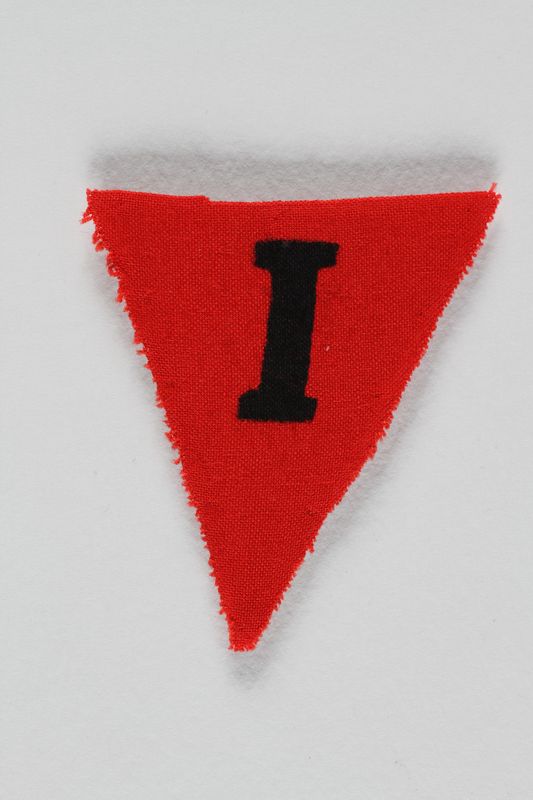Overview
- Brief Narrative
- Inverted red triangle badge printed with a black letter I intended for use as a prisoner identification badge in Langenstein-Zwieberge concentration camp, a subcamp of Buchenwald in Germany. The red identified a political prisoner. The letter could indicate nationality; I may be for Italian. The inverted triangle would have been attached on the left breast of the uniform. The camp was liberated on April 11, by troops from the 399th Battalion, 8th Armored Division, and 83rd Infantry, which captured all the camp records intact. This badge was one of many found by Lt. Colonel Charles F. Ottoman, US Army, on April 22, 1945. It was used as evidence for Case No. 117 "Alleged atrocities at Zwieberge Malachit Concentration Camp" at the Subsequent Nuremberg War Crimes Trials held in Dachau in 1947. Zwieberge subcamps were built from April 1944 to bolster the German war effort. Due to Allied bombings, an underground factory complex was designed to relocate armament works. The major subcamp, Halberstadt-Langenstein-Zwieberge [Malachit / B2 / Landhaus), planned for 2000 inmates, held more than 5000. Prisoners who worked in the tunnels died in about 6 weeks, at a rate of 30-40 per day. About 60% of the 8-10,000 prisoners died. Prisoners were sent to the camp from all regions invaded by Germany. Inmates included Jews, political prisoners, prisoners of war, and asocials, such as criminals, homosexuals, Roma, and vagrants. Living conditions were primitive, food scarce, and disease rampant. The SS camp fuhrer Tscheu was notorious for his cruelty, beatings, lengthy torture sessions, and hangings. The murder of prisoners was a common occurrence. Malachit was evacuated on April 9, 1945, as Allied troops neared. 3000 inmates were sent on a death march, which 500 survived. On April 11, US troops entered the camp. They discovered about 1500 ill and dying inmates who were transferred to a military hospital in Halberstadt. Residents from Langenstein were ordered to bury the dead in mass graves. No postwar trials were held for officers or guards at the Malachit camps, but the captured records of the camp were introduced into evidence for War Crimes cases.
- Date
-
found:
1945 April 22
use: 1947 April-1947 August
- Geography
-
found:
Langenstein-Zwieberge (Concentration camp);
Langenstein (Halberstadt, Germany)
use: Case 117, War Crimes Trials, Subsequent Nuremberg Proceedings; Dachau (Germany)
- Credit Line
- United States Holocaust Memorial Museum Collection, Gift of the National Archives and Records Administration
- Contributor
-
Subject:
Charles F. Ottoman
- Biography
-
Lieutenant Colonel Charles F. Ottoman (April 11, 1890- September 7, 1946) served in the United States Army, Corps of Engineers, during World War II. He handled the investigation of Zwieberge-Malachit concentration camp for evidence of war crimes for use in the War Crimes Trials planned by the Allies following the end of the war. The camp was liberated on April 11, by troops from the 399th Battalion, 8th Armored Division, and 83rd Infantry, which captured all the camp records intact. Immediately following the capture, Lt. Colonel Ottoman discovered and researched the camp materials. He later testified to their provenance for the War Crimes Trials. Malachit was a notoriously cruel camp, where beatings, lengthy torture sessions, hangings, and the murder of prisoners was a common occurrence. No postwar trials were held for officers or guards at the Malachit camps, but the captured records of the camp provided in-depth documentation of atrocities and the concentration camp system which was introduced into evidence for War Crimes cases.
Physical Details
- Language
- German
- Classification
-
Identifying Artifacts
- Category
-
Badges
- Object Type
-
Prisoner badges (ushmm)
- Physical Description
- Lightweight, bright red cloth inverted triangle patch with the uppercase letter I applied in black ink near the top front. It has irregularly cut, slightly frayed edges with faint pinholes. The patch appears unused.
- Dimensions
- overall: Height: 3.000 inches (7.62 cm) | Width: 2.625 inches (6.668 cm)
- Materials
- overall : cotton, ink
- Inscription
- front, top center, black ink : I [likely for Italien/Italian]
Rights & Restrictions
- Conditions on Access
- No restrictions on access
- Conditions on Use
- No restrictions on use
Keywords & Subjects
- Topical Term
- Holocaust, Jewish (1939-1945)--Germany--Langenstein. Concentration camps--Germany--Langenstein. Concentration camp inmates--Italy. Political prisoners--Italy. World War, 1939-1945--Concentration camps--Liberation. World War, 1939-1945-Prisoners and prisons, German.
- Corporate Name
- Langenstein-Zwieberge (Concentration camp)
Administrative Notes
- Legal Status
- Permanent Collection
- Provenance
- The unused cloth badge was transferred to the United States Holocaust Memorial Museum in 1991 by the National Archives and Records Administration.
- Funding Note
- The cataloging of this artifact has been supported by a grant from the Conference on Jewish Material Claims Against Germany.
- Record last modified:
- 2023-08-18 13:57:59
- This page:
- https://collections.ushmm.org/search/catalog/irn4798
Download & Licensing
In-Person Research
- By Appointment
- Request 21 Days in Advance of Visit
- Plan a Research Visit
- Request to See This Object
Contact Us
Also in National Archives and Records Administration collection
The collection consists of unused prisoner identification badges from Langenstein-Zwieberge concentration camp in Germany which were found by Lieutenant Colonel Charles F. Ottoman, United States Army, after the liberation of the camp by American forces, who captured all camp records intact, and which were presented in evidence at the Subsequent Nuremberg Proceedings, War Crimes Trials, in Dachau, Germany, after the war.
Date: 1945 April 22
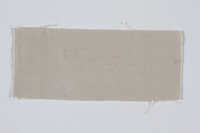
Unused white concentration camp prisoner patch found by US forces
Object
Blank white cloth rectangle intended for use as a prisoner identification badge in Langenstein-Zwieberge concentration camp, a subcamp of Buchenwald in Germany. For use, it would be marked with a prisoner number and attached to the prisoner's uniform, usually on the chest. The camp was liberated on April 11, by troops from the 399th Battalion, 8th Armored Division, and 83rd Infantry, which captured all the camp records intact. This badge was one of many found by Lt. Colonel Charles F. Ottoman, US Army, on April 22, 1945. It was used as evidence for Case No. 117 "Alleged atrocities at Zwieberge Malachit Concentration Camp" at the Subsequent Nuremberg War Crimes Trials held in Dachau in 1947. Zwieberge subcamps were built from April 1944 to bolster the German war effort. Due to Allied bombings, an underground factory complex was designed to relocate armament works. The major subcamp, Halberstadt-Langenstein-Zwieberge [Malachit / B2 / Landhaus), planned for 2000 inmates, held more than 5000. Prisoners who worked in the tunnels died in about 6 weeks, at a rate of 30-40 per day. About 60% of the 8-10,000 prisoners died. Prisoners were sent to the camp from all regions invaded by Germany. Inmates included Jews, political prisoners, prisoners of war, and asocials, such as criminals, homosexuals, Roma, and vagrants. Living conditions were primitive, food scarce, and disease rampant. The SS camp fuhrer Tscheu was notorious for his cruelty, beatings, lengthy torture sessions, and hangings. The murder of prisoners was a common occurrence. Malachit was evacuated on April 9, 1945, as Allied troops neared. 3000 inmates were sent on a death march, which 500 survived. On April 11, US troops entered the camp. They discovered about 1500 ill and dying inmates who were transferred to a military hospital in Halberstadt. Residents from Langenstein were ordered to bury the dead in mass graves. No postwar trials were held for officers or guards at the Malachit camps, but the captured records of the camp were introduced into evidence for War Crimes cases.
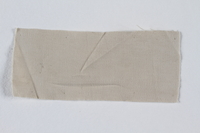
Unused white concentration camp prisoner patch found by US forces
Object
Blank white cloth rectangle intended for use as a prisoner identification badge in Langenstein-Zwieberge concentration camp, a subcamp of Buchenwald in Germany. For use, it would be marked with a prisoner number and attached to the prisoner's uniform, usually on the chest. The camp was liberated on April 11, by troops from the 399th Battalion, 8th Armored Division, and 83rd Infantry, which captured all the camp records intact. This badge was one of many found by Lt. Colonel Charles F. Ottoman, US Army, on April 22, 1945. It was used as evidence for Case No. 117 "Alleged atrocities at Zwieberge Malachit Concentration Camp" at the Subsequent Nuremberg War Crimes Trials held in Dachau in 1947. Zwieberge subcamps were built from April 1944 to bolster the German war effort. Due to Allied bombings, an underground factory complex was designed to relocate armament works. The major subcamp, Halberstadt-Langenstein-Zwieberge [Malachit / B2 / Landhaus), planned for 2000 inmates, held more than 5000. Prisoners who worked in the tunnels died in about 6 weeks, at a rate of 30-40 per day. About 60% of the 8-10,000 prisoners died. Prisoners were sent to the camp from all regions invaded by Germany. Inmates included Jews, political prisoners, prisoners of war, and asocials, such as criminals, homosexuals, Roma, and vagrants. Living conditions were primitive, food scarce, and disease rampant. The SS camp fuhrer Tscheu was notorious for his cruelty, beatings, lengthy torture sessions, and hangings. The murder of prisoners was a common occurrence. Malachit was evacuated on April 9, 1945, as Allied troops neared. 3000 inmates were sent on a death march, which 500 survived. On April 11, US troops entered the camp. They discovered about 1500 ill and dying inmates who were transferred to a military hospital in Halberstadt. Residents from Langenstein were ordered to bury the dead in mass graves. No postwar trials were held for officers or guards at the Malachit camps, but the captured records of the camp were introduced into evidence for War Crimes cases.
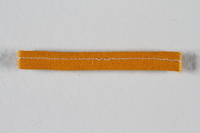
Unused yellow stripe concentration camp prisoner patch found by US forces
Object
Blank yellow bar patch intended for use as an identification badge for a Jewish prisoner in Langenstein-Zwieberge concentration camp, a subcamp of Buchenwald in Germany. This badge would be used with a separate inverted triangle patch, possibly of a different color, to indicate that the prisoner was Jewish. Both patches would be attached to a cloth strip and attached to the uniform, usually on the chest. The camp was liberated on April 11, by troops from the 399th Battalion, 8th Armored Division, and 83rd Infantry, which captured all the camp records intact. This badge was one of many found by Lt. Colonel Charles F. Ottoman, US Army, on April 22, 1945. It was used as evidence for Case No. 117 "Alleged atrocities at Zwieberge Malachit Concentration Camp" at the Subsequent Nuremberg War Crimes Trials held in Dachau in 1947. Zwieberge subcamps were built from April 1944 to bolster the German war effort. Due to Allied bombings, an underground factory complex was designed to relocate armament works. The major subcamp, Halberstadt-Langenstein-Zwieberge [Malachit / B2 / Landhaus), planned for 2000 inmates, held more than 5000. Prisoners who worked in the tunnels died in about 6 weeks, at a rate of 30-40 per day. About 60% of the 8-10,000 prisoners died. Prisoners were sent to the camp from all regions invaded by Germany. Inmates included Jews, political prisoners, prisoners of war, and asocials, such as criminals, homosexuals, Roma, and vagrants. Living conditions were primitive, food scarce, and disease rampant. The SS camp fuhrer Tscheu was notorious for his cruelty, beatings, lengthy torture sessions, and hangings. The murder of prisoners was a common occurrence. Malachit was evacuated on April 9, 1945, as Allied troops neared. 3000 inmates were sent on a death march, which 500 survived. On April 11, US troops entered the camp. They discovered about 1500 ill and dying inmates who were transferred to a military hospital in Halberstadt. Residents from Langenstein were ordered to bury the dead in mass graves. No postwar trials were held for officers or guards at the Malachit camps, but the captured records of the camp were introduced into evidence for War Crimes cases.
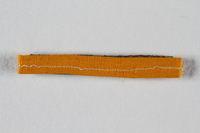
Unused yellow stripe concentration camp prisoner patch found by US forces
Object
Blank yellow bar patch intended for use as an identification badge for a Jewish prisoner in Langenstein-Zwieberge concentration camp, a subcamp of Buchenwald in Germany. This badge would be used with a separate inverted triangle patch, possibly of a different color, to indicate that the prisoner was Jewish. Both patches would be attached to a cloth strip and attached to the uniform, usually on the chest. The camp was liberated on April 11, by troops from the 399th Battalion, 8th Armored Division, and 83rd Infantry, which captured all the camp records intact. This badge was one of many found by Lt. Colonel Charles F. Ottoman, US Army, on April 22, 1945. It was used as evidence for Case No. 117 "Alleged atrocities at Zwieberge Malachit Concentration Camp" at the Subsequent Nuremberg War Crimes Trials held in Dachau in 1947. Zwieberge subcamps were built from April 1944 to bolster the German war effort. Due to Allied bombings, an underground factory complex was designed to relocate armament works. The major subcamp, Halberstadt-Langenstein-Zwieberge [Malachit / B2 / Landhaus), planned for 2000 inmates, held more than 5000. Prisoners who worked in the tunnels died in about 6 weeks, at a rate of 30-40 per day. About 60% of the 8-10,000 prisoners died. Prisoners were sent to the camp from all regions invaded by Germany. Inmates included Jews, political prisoners, prisoners of war, and asocials, such as criminals, homosexuals, Roma, and vagrants. Living conditions were primitive, food scarce, and disease rampant. The SS camp fuhrer Tscheu was notorious for his cruelty, beatings, lengthy torture sessions, and hangings. The murder of prisoners was a common occurrence. Malachit was evacuated on April 9, 1945, as Allied troops neared. 3000 inmates were sent on a death march, which 500 survived. On April 11, US troops entered the camp. They discovered about 1500 ill and dying inmates who were transferred to a military hospital in Halberstadt. Residents from Langenstein were ordered to bury the dead in mass graves. No postwar trials were held for officers or guards at the Malachit camps, but the captured records of the camp were introduced into evidence for War Crimes cases.
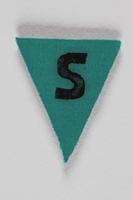
Unused green triangle concentration camp prisoner patch with a black letter S found by US forces
Object
Inverted green triangle patch printed with a black S intended for use as a prisoner identification badge in Langenstein-Zwieberge concentration camp, a subcamp of Buchenwald in Germany. The green identified an accused criminal. The letter could indicate nationality, S possibly for Serbian, Slovakian, Slovenian, or Spanish. In some camps, the letter could indicate status, and the S may mean Sicherungsverwahrt [Preventive detention.] The inverted triangle would have been attached on the left breast of the uniform. The camp was liberated on April 11, by troops from the 399th Battalion, 8th Armored Division, and 83rd Infantry, which captured all the camp records intact. This badge was one of many found by Lt. Colonel Charles F. Ottoman, US Army, on April 22, 1945. It was used as evidence for Case No. 117 "Alleged atrocities at Zwieberge Malachit Concentration Camp" at the Subsequent Nuremberg War Crimes Trials held in Dachau in 1947. Zwieberge subcamps were built from April 1944 to bolster the German war effort. Due to Allied bombings, an underground factory complex was designed to relocate armament works. The major subcamp, Halberstadt-Langenstein-Zwieberge [Malachit / B2 / Landhaus), planned for 2000 inmates, held more than 5000. Prisoners who worked in the tunnels died in about 6 weeks, at a rate of 30-40 per day. About 60% of the 8-10,000 prisoners died. Prisoners were sent to the camp from all regions invaded by Germany. Inmates included Jews, political prisoners, prisoners of war, and asocials, such as criminals, homosexuals, Roma, and vagrants. Living conditions were primitive, food scarce, and disease rampant. The SS camp fuhrer Tscheu was notorious for his cruelty, beatings, lengthy torture sessions, and hangings. The murder of prisoners was a common occurrence. Malachit was evacuated on April 9, 1945, as Allied troops neared. 3000 inmates were sent on a death march, which 500 survived. On April 11, US troops entered the camp. They discovered about 1500 ill and dying inmates who were transferred to a military hospital in Halberstadt. Residents from Langenstein were ordered to bury the dead in mass graves. No postwar trials were held for officers or guards at the Malachit camps, but the captured records of the camp were introduced into evidence for War Crimes cases.
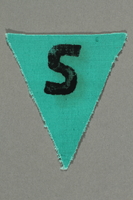
Unused green triangle concentration camp prisoner patch with a black letter S found by US forces
Object
Inverted green triangle patch printed with a black S intended for use as a prisoner identification badge in Langenstein-Zwieberge concentration camp, a subcamp of Buchenwald in Germany. The green identified an accused criminal. The letter could indicate nationality, S possibly for Serbian, Slovakian, Slovenian, or Spanish. In some camps, the letter could indicate status, and the S may mean Sicherungsverwahrt [Preventive detention.] The inverted triangle would have been attached on the left breast of the uniform. The camp was liberated on April 11, by troops from the 399th Battalion, 8th Armored Division, and 83rd Infantry, which captured all the camp records intact. This badge was one of many found by Lt. Colonel Charles F. Ottoman, US Army, on April 22, 1945. It was used as evidence for Case No. 117 "Alleged atrocities at Zwieberge Malachit Concentration Camp" at the Subsequent Nuremberg War Crimes Trials held in Dachau in 1947. Zwieberge subcamps were built from April 1944 to bolster the German war effort. Due to Allied bombings, an underground factory complex was designed to relocate armament works. The major subcamp, Halberstadt-Langenstein-Zwieberge [Malachit / B2 / Landhaus), planned for 2000 inmates, held more than 5000. Prisoners who worked in the tunnels died in about 6 weeks, at a rate of 30-40 per day. About 60% of the 8-10,000 prisoners died. Prisoners were sent to the camp from all regions invaded by Germany. Inmates included Jews, political prisoners, prisoners of war, and asocials, such as criminals, homosexuals, Roma, and vagrants. Living conditions were primitive, food scarce, and disease rampant. The SS camp fuhrer Tscheu was notorious for his cruelty, beatings, lengthy torture sessions, and hangings. The murder of prisoners was a common occurrence. Malachit was evacuated on April 9, 1945, as Allied troops neared. 3000 inmates were sent on a death march, which 500 survived. On April 11, US troops entered the camp. They discovered about 1500 ill and dying inmates who were transferred to a military hospital in Halberstadt. Residents from Langenstein were ordered to bury the dead in mass graves. No postwar trials were held for officers or guards at the Malachit camps, but the captured records of the camp were introduced into evidence for War Crimes cases.

Unused pink triangle concentration camp prisoner patch with a black letter T found by US forces
Object
Inverted deep pink triangle badge printed with a black letter T intended for use as a prisoner identification badge in Langenstein-Zwieberge concentration camp, a subcamp of Buchenwald in Germany. The pink identified an accused homosexual. The letter could indicate nationality; T may be for Czechoslovakian. The inverted triangle would have been attached on the left breast of the uniform. The camp was liberated on April 11, by troops from the 399th Battalion, 8th Armored Division, and 83rd Infantry, which captured all the camp records intact. This badge was one of many found by Lt. Colonel Charles F. Ottoman, US Army, on April 22, 1945. It was used as evidence for Case No. 117 "Alleged atrocities at Zwieberge Malachit Concentration Camp" at the Subsequent Nuremberg War Crimes Trials held in Dachau in 1947. Zwieberge subcamps were built from April 1944 to bolster the German war effort. Due to Allied bombings, an underground factory complex was designed to relocate armament works. The major subcamp, Halberstadt-Langenstein-Zwieberge [Malachit / B2 / Landhaus), planned for 2000 inmates, held more than 5000. Prisoners who worked in the tunnels died in about 6 weeks, at a rate of 30-40 per day. About 60% of the 8-10,000 prisoners died. Prisoners were sent to the camp from all regions invaded by Germany. Inmates included Jews, political prisoners, prisoners of war, and asocials, such as criminals, homosexuals, Roma, and vagrants. Living conditions were primitive, food scarce, and disease rampant. The SS camp fuhrer Tscheu was notorious for his cruelty, beatings, lengthy torture sessions, and hangings. The murder of prisoners was a common occurrence. Malachit was evacuated on April 9, 1945, as Allied troops neared. 3000 inmates were sent on a death march, which 500 survived. On April 11, US troops entered the camp. They discovered about 1500 ill and dying inmates who were transferred to a military hospital in Halberstadt. Residents from Langenstein were ordered to bury the dead in mass graves. No postwar trials were held for officers or guards at the Malachit camps, but the captured records of the camp were introduced into evidence for War Crimes cases.
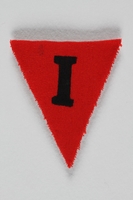
Unused red triangle concentration camp prisoner patch with a black letter I found by US forces
Object
Inverted red triangle badge printed with a black letter I intended for use as a prisoner identification badge in Langenstein-Zwieberge concentration camp, a subcamp of Buchenwald in Germany. The red identified a political prisoner. The letter could indicate nationality; I may be for Italian. The inverted triangle would have been attached on the left breast of the uniform. The camp was liberated on April 11, by troops from the 399th Battalion, 8th Armored Division, and 83rd Infantry, which captured all the camp records intact. This badge was one of many found by Lt. Colonel Charles F. Ottoman, US Army, on April 22, 1945. It was used as evidence for Case No. 117 "Alleged atrocities at Zwieberge Malachit Concentration Camp" at the Subsequent Nuremberg War Crimes Trials held in Dachau in 1947. Zwieberge subcamps were built from April 1944 to bolster the German war effort. Due to Allied bombings, an underground factory complex was designed to relocate armament works. The major subcamp, Halberstadt-Langenstein-Zwieberge [Malachit / B2 / Landhaus), planned for 2000 inmates, held more than 5000. Prisoners who worked in the tunnels died in about 6 weeks, at a rate of 30-40 per day. About 60% of the 8-10,000 prisoners died. Prisoners were sent to the camp from all regions invaded by Germany. Inmates included Jews, political prisoners, prisoners of war, and asocials, such as criminals, homosexuals, Roma, and vagrants. Living conditions were primitive, food scarce, and disease rampant. The SS camp fuhrer Tscheu was notorious for his cruelty, beatings, lengthy torture sessions, and hangings. The murder of prisoners was a common occurrence. Malachit was evacuated on April 9, 1945, as Allied troops neared. 3000 inmates were sent on a death march, which 500 survived. On April 11, US troops entered the camp. They discovered about 1500 ill and dying inmates who were transferred to a military hospital in Halberstadt. Residents from Langenstein were ordered to bury the dead in mass graves. No postwar trials were held for officers or guards at the Malachit camps, but the captured records of the camp were introduced into evidence for War Crimes cases.
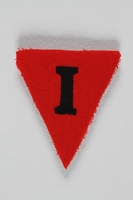
Unused red triangle concentration camp prisoner patch with a black letter I found by US forces
Object
Inverted red triangle badge printed with a black letter I intended for use as a prisoner identification badge in Langenstein-Zwieberge concentration camp, a subcamp of Buchenwald in Germany. The red identified a political prisoner. The letter could indicate nationality; I may be for Italian. The inverted triangle would have been attached on the left breast of the uniform. The camp was liberated on April 11, by troops from the 399th Battalion, 8th Armored Division, and 83rd Infantry, which captured all the camp records intact. This badge was one of many found by Lt. Colonel Charles F. Ottoman, US Army, on April 22, 1945. It was used as evidence for Case No. 117 "Alleged atrocities at Zwieberge Malachit Concentration Camp" at the Subsequent Nuremberg War Crimes Trials held in Dachau in 1947. Zwieberge subcamps were built from April 1944 to bolster the German war effort. Due to Allied bombings, an underground factory complex was designed to relocate armament works. The major subcamp, Halberstadt-Langenstein-Zwieberge [Malachit / B2 / Landhaus), planned for 2000 inmates, held more than 5000. Prisoners who worked in the tunnels died in about 6 weeks, at a rate of 30-40 per day. About 60% of the 8-10,000 prisoners died. Prisoners were sent to the camp from all regions invaded by Germany. Inmates included Jews, political prisoners, prisoners of war, and asocials, such as criminals, homosexuals, Roma, and vagrants. Living conditions were primitive, food scarce, and disease rampant. The SS camp fuhrer Tscheu was notorious for his cruelty, beatings, lengthy torture sessions, and hangings. The murder of prisoners was a common occurrence. Malachit was evacuated on April 9, 1945, as Allied troops neared. 3000 inmates were sent on a death march, which 500 survived. On April 11, US troops entered the camp. They discovered about 1500 ill and dying inmates who were transferred to a military hospital in Halberstadt. Residents from Langenstein were ordered to bury the dead in mass graves. No postwar trials were held for officers or guards at the Malachit camps, but the captured records of the camp were introduced into evidence for War Crimes cases.
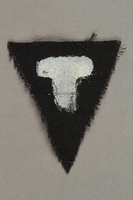
Unused black triangle concentration camp patch with a white letter T found by US forces
Object
Inverted, triangular black badge with a white T intended for use as a prisoner identification badge in Langenstein-Zwieberge concentration camp, a subcamp of Buchenwald in Germany. The black signified that the inmate was considered asocial, used to refer to those too deviant, lazy, or selfish to contribute to society. This flexible category could include addicts and alcoholics, disabled, homeless, homosexuals, pacifists, vagrants, or Roma. The letter could indicate nationality; T may be for Czechoslovakian. The inverted triangle would have been attached on the left breast of the jacket or on the pants leg. The camp was liberated on April 11, by troops from the 399th Battalion, 8th Armored Division, and 83rd Infantry, which captured all the camp records intact. This badge was one of many found by Lt. Colonel Charles F. Ottoman, US Army, on April 22, 1945. It was used as evidence for Case No. 117 "Alleged atrocities at Zwieberge Malachit Concentration Camp" at the Subsequent Nuremberg War Crimes Trials held in Dachau in 1947. Zwieberge subcamps were built from April 1944 to bolster the German war effort. Due to Allied bombings, an underground factory complex was designed to relocate armament works. The major subcamp, Halberstadt-Langenstein-Zwieberge [Malachit / B2 / Landhaus), planned for 2000 inmates, held more than 5000. Prisoners who worked in the tunnels died in about 6 weeks, at a rate of 30-40 per day. About 60% of the 8-10,000 prisoners died. Prisoners were sent to the camp from all regions invaded by Germany. Inmates included Jews, political prisoners, prisoners of war, and asocials, such as criminals, homosexuals, Roma, and vagrants. Living conditions were primitive, food scarce, and disease rampant. The SS camp fuhrer Tscheu was notorious for his cruelty, beatings, lengthy torture sessions, and hangings. The murder of prisoners was a common occurrence. Malachit was evacuated on April 9, 1945, as Allied troops neared. 3000 inmates were sent on a death march, which 500 survived. On April 11, US troops entered the camp. They discovered about 1500 ill and dying inmates who were transferred to a military hospital in Halberstadt. Residents from Langenstein were ordered to bury the dead in mass graves. No postwar trials were held for officers or guards at the Malachit camps, but the captured records of the camp were introduced into evidence for War Crimes cases.
Unused pink triangle concentration camp prisoner patch with a black letter B found by US forces
Object
Inverted deep pink triangle badge printed with a black letter B intended for use as a prisoner identification badge in Langenstein-Zwieberge concentration camp, a subcamp of Buchenwald in Germany. The pink identified an accused homosexual. The letter could indicate nationality; B may be for Belgian. The inverted triangle would have been attached on the left breast of the uniform. The camp was liberated on April 11, by troops from the 399th Battalion, 8th Armored Division, and 83rd Infantry, which captured all the camp records intact. This badge was one of many found by Lt. Colonel Charles F. Ottoman, US Army, on April 22, 1945. It was used as evidence for Case No. 117 "Alleged atrocities at Zwieberge Malachit Concentration Camp" at the Subsequent Nuremberg War Crimes Trials held in Dachau in 1947. Zwieberge subcamps were built from April 1944 to bolster the German war effort. Due to Allied bombings, an underground factory complex was designed to relocate armament works. The major subcamp, Halberstadt-Langenstein-Zwieberge [Malachit / B2 / Landhaus), planned for 2000 inmates, held more than 5000. Prisoners who worked in the tunnels died in about 6 weeks, at a rate of 30-40 per day. About 60% of the 8-10,000 prisoners died. Prisoners were sent to the camp from all regions invaded by Germany. Inmates included Jews, political prisoners, prisoners of war, and asocials, such as criminals, homosexuals, Roma, and vagrants. Living conditions were primitive, food scarce, and disease rampant. The SS camp fuhrer Tscheu was notorious for his cruelty, beatings, lengthy torture sessions, and hangings. The murder of prisoners was a common occurrence. Malachit was evacuated on April 9, 1945, as Allied troops neared. 3000 inmates were sent on a death march, which 500 survived. On April 11, US troops entered the camp. They discovered about 1500 ill and dying inmates who were transferred to a military hospital in Halberstadt. Residents from Langenstein were ordered to bury the dead in mass graves. No postwar trials were held for officers or guards at the Malachit camps, but the captured records of the camp were introduced into evidence for War Crimes cases.

